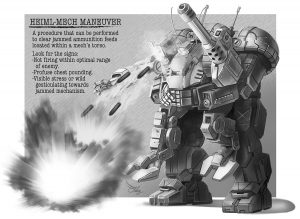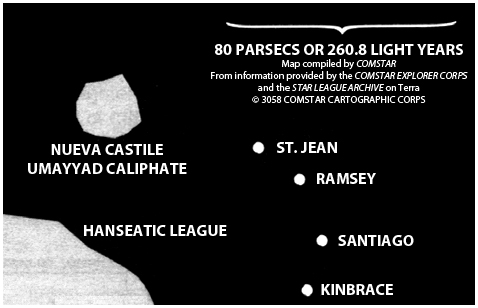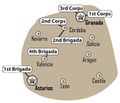Umayyad Caliphate
Sarna News

- Bad ‘Mechs - Sentinel
- HEXTECH Review - Wave 3 Brings More Urban Options To Your Battlefield
- Your BattleTech News Round-Up For March, 2024
- Crashing 'Mechs With Jennifer Brozek, Author Of The Rogue Academy Trilogy
- Getting The Word Out With Rem Alternis, Catalyst Community & Marketing Director
- Read more →
This article needs to be updated with material from Masters and Minions: The StarCorps Dossiers, Wars of Reaving. Once these titles clear the Moratorium period, or if they already have, please consider revisiting this article and updating it with the new material. |
Property "Update Needed From" (as page type) with input value "Masters and Minions: The StarCorps Dossiers]], [[Wars of Reaving" contains invalid characters or is incomplete and therefore can cause unexpected results during a query or annotation process.
| 160px | |
| The Umayyad Caliphate | |
|---|---|
| Faction Profile | |
| Time period: | 2830 – present |
| Classification: | Deep Periphery Proto-state |
| Controlled systems: | 1 plus 1 contested |
| Capital world: | Granada |
| Ruler title: | Caliph |
| Military: | Umayyad Corps |
| Secret Service: | unknown |
The Umayyad Caliphate is a small state residing within the Deep Periphery. The Umayyads are in a region of space roughly seventy-five light years in diameter, situated 150 light years coreward from the Hanseatic League and 200 light years anti-spinward from the Clan Jade Falcon colony St. Jean. Originally separate entities, more than 200 years of continuous warfare and shared history has inextricably bound the Umayyads to Nueva Castile, even resulting in the intermingling of some bloodlines.
Contents
History
Nueva Castile started as a pre-Star League colony. The first settlers were Iberian, and landed on the world of Castile in 2392. These settlers established a feudal agrarian society. A total of nine planets were settled: Aragon, Asturias, Castile, Córdoba, Galicia, Granada, León, Navarre and Valencia. Due to the great physical displacement between Nueva Castile and the Inner Sphere, the realm lingered in peace and isolation, unaware of war and politics for over 400 years.
The history of this region of space changed fundamentally in 2830, when a single JumpShip arrived in the Granada system. This JumpShip transported a group of refugees, armed with heretofore unknown technology, including BattleMechs. It is unknown where these invaders came from, or even if the invaders were aware of their origins, but their significant technological advantage resulted in the conquest of Granada. The native Castilians dubbed these invaders the "Umayyads", a reference to the Islamic empire that invaded the Iberian peninsula around 1½ milenia before. The name stuck. Despite the small numbers of Umayyad forces, the Umayyad Caliphate quickly conquered several more worlds. By 2855, only the world of Asturias remained free from the Umayyad conquest.
Some sources show that in 2825 a single exploration JumpShip of the fleeing Clan Wolverine fleet found a Spanish-speaking colony, was ordered to start negotiations for and trade with those colonies, but never returned to the main fleet. It is possible, that the Umayyad invaders were the crew of exactly this Wolverine ship. There exist valid hypotheses that explain the 5 year difference between the disappearance of the Wolverine JumpShip and the arrival of Umayyad.[1]
The Umayyad conqest of Nueva Castile would have been completed were it not for infighting resulting from the division of the spoils. As a result, Castilian forces commanded by Ferdinand Rodriguez were able to capture several BattleMechs in 2857. By 2862, the Castilians had reverse engineered the technology, and were fielding many primitive Internal Combustion Engine-powered 'Mechs, enough to turn the tide of war. Between 2862 and 3062, the Castilians gradually liberated most of their worlds, first Castile and León, then Aragon, Navarre, Galicia and Valencia. Only two worlds remained in Umayyad control, the disputed world of Córdoba and the Umayyad capital Granada.
The 230+ year war reached a cease-fire when operatives working for the Word of Blake revealed to both parties outside powers have been conspiring to prolong the conflict, aiding both sides in such a way as to prevent either from achieving a complete victory. In light of this revelation, both parties have been a process of reconciliation.
Umayyad Society
The Umayyads have a martial, feudal society ruled by a monarch, but unlike the Castilians, merit (political and martial) and unwavering loyalty determine one's place in Umayyad society. Upward and downward mobility are the rule, and within one's class democratic principles are prevalent. However, only those people who can trace descent from one of the original Umayyad invaders are allowed to participate in war; rising into the Umayyad nobility (and upper echelons of command) is difficult. Sciences and arts are easily visible within Umayyad society, and capital punishment is almost unheard of.
Umayyad people also possess no currency; barter is the norm. Society is far more open (as compared with that of Nueva Castile), and there is limited democracy. The Umayyads speak Arabic, English and Russian and practice Islam, but like the Castilians, more than 230 years of shared history has allowed some intermingling of Umayyad and Castilian heritage.
Military
The Caliphate maintains a large combined arms military supported by small units of BattleMechs. In the field, the army fights as lances of infantry, combat vehicles and 'Mechs. These units fight as mixed companies. Umayyad Technology is roughly equivalent to that of the Inner Sphere in 3025.
The Umayyad military is not centrally governed, but is a coalition of warriors hailing from all parts of Umayyad society. The Umayyad military is therefore very open, and outside of rank and unit cohesion, soldiers possess a lot of freedom. There is no standard uniform - small units of soldiers generally derive their colors from personal heraldry and the heraldry of unit commanders. The Umayyad have also learned from the infighting which doomed their initial invasion - feuding is discouraged, and non-lethal honor duels (fought with swords) are the most common means to ending a bitter dispute.
One might expect such a fighting force incapable of waging war. Not so! The Umayyads form an extremely cohesive fighting force. Honor and bravery are regarded with the utmost of respect, and cowardice viewed with contempt. These mores extend to the Umayyad's foes, and Castilian acts of uncommon bravery are celebrated. Further, the honor of vehicle crews and 'Mech pilots transfers to their mounts. The honor of one's weapons is also regarded as sacrosanct, and to bring great dishonor or cowardice to a long-honorable combat vehicle or 'Mech is sacrilegious.
Ranks
Umayyad ranks possess duties both martial and civic. Ranks are achieved through merit and seniority.
- Caliph – A Caliph is elected annually on Granada from among the Atabegs. Caliphs mediate disputes among the Atabegs and determine Umayyad martial policy. Originally, Caliphs, like Castilian Kings, served for life once elected. This policy changed when Caliph Joshua Murray attempted to install his son as successor.
- Atabegs – A noble in command of an Umayyad city-state. Atabegs are also regiment commanders, and must have 10 years of military experience.
- Amir mi’a – A battalion commander. Mi'as must also possess at least 5 years of military service.
- Amir kabir – A company commander. Kabirs must also possess at least 2 years experience.
- Amir ‘ashara – A lance commander.
- Safiya – A warrior.
Organization
The Umayyads maintain a standing army of approximately eleven regiments, two battalions of which are solely 'Mechs. BattleMechs are fielded alone, but never in large numbers, and then only for very specialized missions.
- The 1st Corps consists of 5 mixed regiments, and about a battalion of 'Mechs. The 1st is highly mobile, and is used as a reaction force.
- The veteran 2nd Corps consists of 3 mixed regiments and a full battalion of 'Mechs. The 2nd wages war as a mixed strike force, and fights the Castilian 2nd Brigada on Córdoba.
- The 3rd Corps consists of 3 mixed regiments without any significant 'Mech assets. The 3rd is a permanent garrison force stationed on Granada.
Relations
Umayyad policies towards outsiders have been traditionally cordial as they sought outside intervention (and even trade) to gain the decisive advantage required to conquer Nueva Castile. The Hanseatic League, unbeknownst to the Umayyad, used this state of affairs to their advantage. The League effectively shaped the course of recent Castilian/Umayyad history by brokering mercenary deals and supplying arms in such a way as to prolong the strife. It was not until the late 3060s that the true extent of this interference was realized, though they were deceived even then. Both sides only recognize the Hansa as free traders. They believe that Inner Sphere powers, specifically the Lyran Alliance, not the Hanseatic League, meddled in their domestic affairs.
Since the revelation that outsiders have secretly meddled in Castilian and Umayyad politics, relative peace has endured with only small raiding parties occasionally drawing blood. The Umayyads people have even begun the reconciliation process with the Castilian people, but centuries of warfare will probably prevent any concerted response against an Inner Sphere Successor State for some time.[2]
In 3067, the Caliph of the Umayyad Caliphate is Lisa Burrill.



